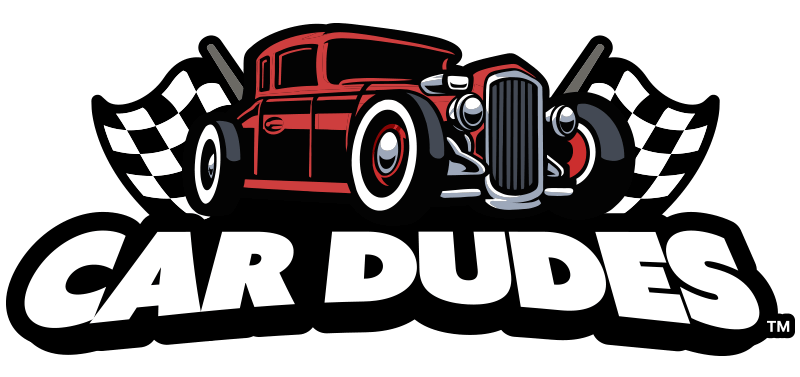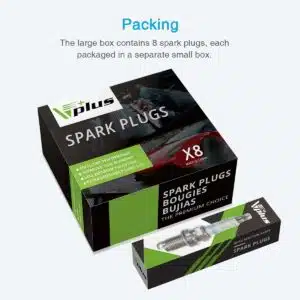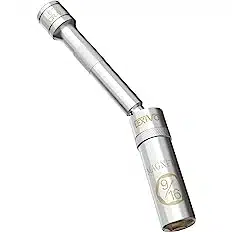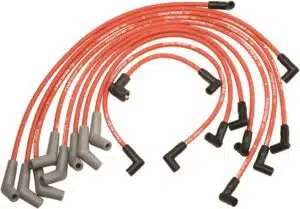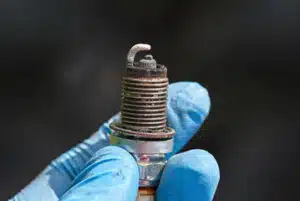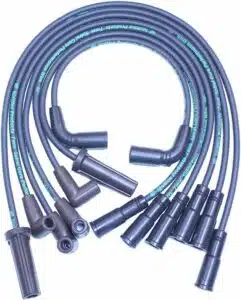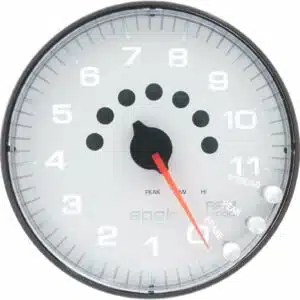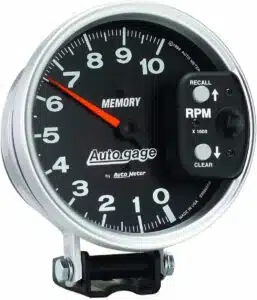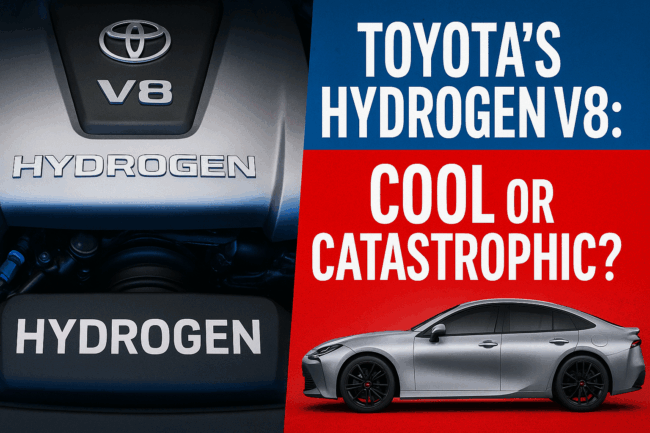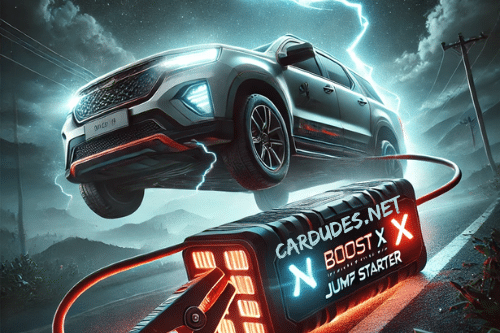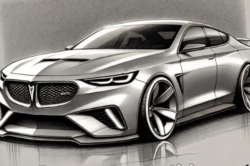“Race car drivers choose E3 spark plugs for the unbeatable combination of reliability and record-breaking speed.”
Born to Burn – With E3 DiamondFIRE Technology\
- Reference number: SP546, PZT14F, PZT1F, PZT2F, PZT2FF4, SP421, SP462, SP507, SP515 spark plugs.
- Iridium spark plugs/One order = 8 Pieces. Thread Size: 14mm. Installation/removal suggestion: Use a spark plug torque wrench to install or remove the spark plug, and adjust the installation torque to 25~30N.m 2.5~3.5kgf-m.
- Replacement racing spark plug used by many professional car drivers.
- Specifically designed with colder heat ranges than the factory plug to enable performance modifications and handle intense conditions
- Please input your make, model and trim level into the Amazon Garage and check the part number before purchasing to ensure fitment.
| E3 Spark Plugs | Regular Spark Plugs |
|---|---|
| Designed to improve the ignition cycles of the air-fuel mixture inside your engine’s combustion chamber, resulting in a more complete and cleaner burn | Typically made of a ceramic insulator with a metal casing that is screwed into the engine block |
| Engineered to be environmentally friendly with a more complete and cleaner burn | Work by creating an electrical spark that ignites the fuel-air mixture in the combustion chamber of your engine |
| Offer increased performance, reduced engine emissions, and a better burn for your automotive, powersports, and small engine spark plug | Quality can affect how well your engine runs, as well as its fuel efficiency and emissions |
| Feature a sophisticated design that includes a copper core electrode and an open ground electrode design | Made of a ceramic insulator with a metal casing |
| Made of copper in the core, with the tip made of a nickel alloy | – |
| Flame kernel may be directed to the piston compared to typical J-wire systems due to its open ground electrode design | – |
| Compact design reduces the transit time to the compressed gas chamber | – |
“Bundled Selections”
A. Revitalize Your Ride with E3 Spark Plugs for Peak Performance!
Unleash the true potential of your engine with E3 Spark Plugs featuring the revolutionary DiamondFIRE ground electrode. Boost power output, enhance fuel economy, and slash emissions. Experience smoother acceleration and idle, harnessing the patented technology for a more complete burn of the fuel/air mixture. Elevate your driving experience and enjoy a 3%-6% power improvement on average in typical operating ranges. Plus, contribute to a greener environment with reduced carbon emissions!
B. Maximize Power and Efficiency with E3 Spark Plugs – A Game-Changer for Your Engine!
Transform your driving experience with E3 Spark Plugs, engineered for unparalleled performance. The DiamondFIRE ground electrode configuration enhances combustion pressure during each power stroke, delivering a significant power boost, improved fuel economy, and reduced emissions. Feel the difference with smoother acceleration and idle, as the patented DiamondFIRE ground electrode ensures a more complete burn of the fuel/air mixture. Witness a 3%-6% average power increase and revel in 3%-4% improved Brake Specific Fuel Consumption. Upgrade your engine and drive with confidence while contributing to a cleaner planet!
C. Ignite Excellence in Your Engine with E3 Spark Plugs – Unleash Power and Eco-Friendliness!
Elevate your engine’s performance to new heights with E3 Spark Plugs, the epitome of innovation. The DiamondFIRE ground electrode configuration is your key to increased combustion pressure, translating to remarkable power output, enhanced fuel efficiency, and minimized emissions in all gasoline engines. Experience the luxury of smoother acceleration and idle, thanks to the patented DiamondFIRE ground electrode ensuring a more thorough burn of the fuel/air mixture. Boost power by 3%-6% on average in typical operating ranges, and witness a 3%-4% improvement in Brake Specific Fuel Consumption. Join the movement for a cleaner environment – E3’s advanced technology drastically reduces carbon emissions and carbon buildup!
ATTN: If you are changing out your spark plugs, we highly suggest you get new plug wires, distributor cap-n-rotor too.. !
E3 OE & MSD Replacements
Click Here or Below to Check’Em Out.. !
“A race car driver dances with the Tachometers’ tune.”
Click Here or Below to Check’Em Out.. !
- Traditional incandescent lighting illuminates the front of the dial
- 12 and 16 volt compatible, well-suited with nearly every street car or race car electrical system
- Auto Meter’s race proven air-core electric tachometers provide quick and accurate readings with a needle so responsive it can go from 0 – full scale in 333 milliseconds
- Compatible with 2 – 4 pulse ignition signals (4-8 cylinder engines) with points, electronic, and most 12V high-performance racing ignitions.
- Triage engine health and setup changes using Peak RPM Memory recall with one touch review. Commonly referred to as the ‘tattle tale’ in the racing world, this function allows racers to gain quick insights between rounds about wheel spin, gearing and gear changes.
| Car Name | Year | Description |
|---|---|---|
| 1964 Pontiac GTO | 1964 | Often considered the first true muscle car, the GTO was a powerful and stylish vehicle that set the stage for the muscle car era. |
| 1967 Chevrolet Camaro | 1967 | The Camaro, introduced as a competitor to the Ford Mustang, became a symbol of American muscle with various performance options. |
| 1969 Ford Mustang Boss 429 | 1969 | The Boss 429 featured a massive 429 cubic-inch engine and was built for drag racing, making it a highly sought-after classic. |
| 1969 Dodge Charger R/T | 1969 | Known for its distinctive design, the Charger R/T came with a range of powerful V8 engines and was popularized by the TV show “The Dukes of Hazzard.” |
| 1968 Plymouth Road Runner | 1968 | Designed to be a no-frills, budget-friendly muscle car, the Road Runner was known for its affordability and performance. |
| 1966 Shelby GT350 | 1966 | Carroll Shelby’s modified Mustang GT350 was a high-performance version of the Mustang, tuned for racing and road performance. |
| 1969 Chevrolet Chevelle SS | 1969 | The Super Sport (SS) version of the Chevelle offered a range of powerful V8 engines and is highly regarded for its performance. |
| 1966 Oldsmobile 4-4-2 | 1966 | The 4-4-2 (pronounced “four-four-two”) was an Oldsmobile muscle car with a 400 cubic-inch V8 engine and strong performance credentials. |
| 1969 Plymouth Barracuda | 1969 | The Barracuda, especially in its high-performance versions like the ‘Cuda, offered impressive power and style. |
| 1968 Dodge Dart Hemi Super Stock | 1968 | This lightweight Dart was designed for drag racing and featured a potent 426 Hemi engine. |
Here’s some drag racing lingo I’ll bet you didn’t know..
Backpedal
When a driver lets off the throttle to regain traction and avoid or stop tire shake.
Breakout
Used only in handicap racing, “breakout” refers to a vehicle running quicker than the racer has predicted. The racer who breaks out loses unless his or her opponent breaks out by more or commits a more serious foul, such as leaving too soon (see “red-light”) or crossing the centerline.
Bubble
The bottom spot in the field, usually the No. 16 qualifying position. Also called the “bump.”
Bumped
When a racer is moved from a higher qualifying position to a lower one after another competitor improves.
Burnout
Spinning the rear tires in water before a run to heat and clean them and put rubber on the track for better traction. Also, the specks of tire rubber that result from a burnout; for example, “You really need to wash the burnout off your face.”
Christmas Tree
Also called the Tree, the electronic starting device between the lanes on the starting line.
Chute
Short for parachute, this device helps slow the car at the end of a run.
Deep Stage
To roll a few inches farther into the stage beam. In that position, a racer is closer to the finish line and also closer to a foul start (red-light).
Dial-Under
Used by drivers in Super Stock and Stock who select an elapsed time quicker than the national index. Drivers select a dial-under, or e.t., that they think their car will run based on previous performance.
Digger
Another word for dragster.
Digs
Drag racing event; for example, “See you at the digs next weekend.”
DNQ
Did not qualify.
Door Slammer
Car with doors.
Elapsed Time (E.T.)
The time it takes a vehicle to travel from the starting line to the finish line.
Eliminations
When vehicles are raced two at a time, resulting in one winner and one loser. Winners continue to race in tournament-style competition until one remains.
Flopper
Another word for a Funny Car.
Foul Start
When a vehicle leaves the starting line before the green light, indicated by a red light on the Tree. The racer is eliminated from further competition in that eliminator at the event (unless his or her opponent commits a worse infraction).
Full Tree
Used in Comp, Super Stock, and Stock, for which a handicap starting system equalizes competition. The three amber lights flash consecutively five- tenths of a second apart, followed five-tenths later by the green light.
Groove
Path of traction laid down by other vehicles that have gone down the racetrack; for example, “in the groove.”
Guardwalls
The walls that line the racing surface.
Handicap
The head start given to the slower car in a race featuring two vehicles of varying performance potentials. Used in Comp, Super Stock, and Stock.
Hide
Tire; for example, “He was smokin’ the hides.”
Hole Shot
Starting-line advantage achieved by the quicker-reacting driver that results in a win despite a slower e.t.; for example, “She put a hole shot on him.”
Index
An e.t. assigned by NHRA as a predictor of performance for vehicles in that class. Indexes allow various classes of cars in the same eliminator to race competitively.
Interval Timers
Elapsed-time clocks at 60, 330, 660, and 1,000 feet to record the intervals from the starting line.
Loose
When a car gets out of the groove; for example, “He got loose at about 60 feet.”
Loud Pedal
Gas pedal or throttle.
Methanol
Pure methyl alcohol produced by synthesis; used in Top Alcohol Dragsters and Top Alcohol Funny Cars.
Nitromethane
Known as “nitro,” CH3NO2 is the result of a chemical reaction between nitric acid and propane. Primary fuel for Top Fuel dragsters, Funny Cars, and injected nitro dragsters in Top Alcohol Dragster.
Oil Down
When a race car deposits oil from the engine onto the racing surface, causing a delay.
On the Trailer
Where a race car is put after losing or not qualifying; for example, “He was on the trailer after round one.”
Pre-Staged
When a racer is approximately seven inches behind the starting line and the small yellow light atop his or her side of the Christmas Tree is illuminated.
Pro Tree
Used in Top Fuel, Funny Car, Pro Stock, Pro Stock Motorcycle, Top Alcohol Dragster, Top Alcohol Funny Car, Super Comp, Super Gas, and Super Street, all of which feature heads-up (no handicap) competition. All three large amber lights on the Tree flash simultaneously, followed four-tenths of a second later by the green starting light.
Rail
Another name for a dragster.
Reaction Time
The time it takes for a vehicle’s front tires to clear the staging beam after the green light comes on; measured in fractions of a second. A perfect reaction time is .000.
Red-Light
When a race car leaves the starting line too soon – before the green light or “go” signal – it activates the red light on the Christmas Tree, and the driver is automatically disqualified.
Safety Safari
A team of men and women responsible for transporting equipment from race to race, preparing and maintaining the racing surface, and providing support in an emergency.
Sand Trap
Located beyond the shutdown area; used to help stop errant race cars.
Shoe
Another name for a driver.
Shutdown Area
Area past the finish line where race vehicles come to a stop and racers are picked up by their crews.
Sixty-Foot Time
The time it takes a vehicle to cover the first 60 feet of the racetrack. It is the most accurate measure of the launch from the starting line and is the interval most critical to a quick e.t.
Slick
Racing tire that does not have tread.
Smoked the Tires
When a car loses traction; also “blew the tires off” or “hazed the tires.”
Speed Trap
The final 66 feet to the finish line where speed is calculated.
Staged
A racer is staged when the front wheel or wheels of the vehicle are on the starting line. Once the racer is staged, the calibrated countdown of the amber lights leading to the green starting light may begin anytime.
Time Slip
Given to the racer or crew after a run, it lists the elapsed time, reaction time, and speed.
Tire Shake
Result of losing traction.
Tree’d
A racer whose reaction time is significantly slower than an opponent’s is said to have been Tree’d.
The Wally
Official NHRA trophy.
Wally Parks
NHRA founder (1913-2007), for whom the Wally is named.
